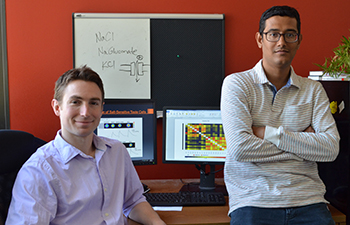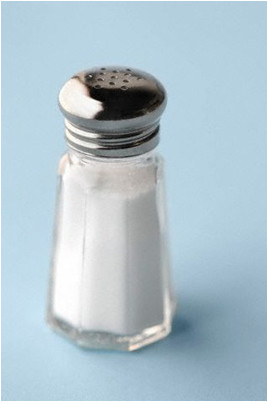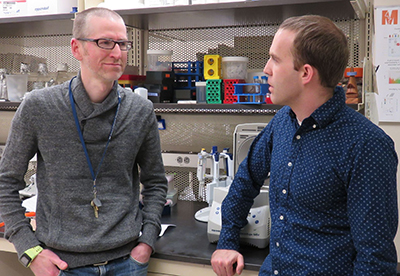Like Dr. Jekyll and Mr. Hyde, salt has two personalities. On one hand, we all need salt to survive; this is the biological reason for why it tastes so good. On the other, overconsumption can be unhealthy, contributing to high blood pressure, heart attack and stroke.
 Photo Credit: © 2010 Iain Watson, Flickr | CC-BY | via Wylio
Photo Credit: © 2010 Iain Watson, Flickr | CC-BY | via Wylio
The question of how to balance the good with the bad is a pressing 21st century public health issue. The answer demands an understanding of how salty taste works, in part to facilitate development of salt substitutes or enhancers.
And even in this age of extraordinary scientific breakthroughs, how salty taste works – specifically, the molecular identity of the receptors that detect salty-tasting chemicals – remains unknown.
Monell postdoctoral fellows Brian Lewandowski and Sunil Sukumaran are on a scientific quest to find a salt receptor, maybe more than one. However, they have a big problem, namely – how do you find something when you don’t really know what you’re looking for? Luckily, the intrepid postdocs have a few clues about their target: they know that it includes one or more proteins and suspect that it is located in the cellular membrane of salt-responding taste cells.
But even with that information, their search could be likened to looking for a needle in a haystack.
Monell + Omics = Monellomics
In classic Monell interdisciplinary fashion, the neuroscientist (Lewandowski) and the molecular biologist (Sukumaran) are combining forces to start their search from scratch. Taking their cue from J.R.R. Tolkien, who wrote, “Not all those who wander are lost,” their focused approach uses a powerful new field of study called transcriptomics to collect and methodically sift through vast amounts of molecular information.
 Brian Lewandowski, PhD (left) and Sunil Sukumaran, PhD
Brian Lewandowski, PhD (left) and Sunil Sukumaran, PhD
“We want to find one of the last unknown taste receptors, the generalist salt receptor,” explains Lewandowski. “Instead of looking at specific prospects, we are identifying all the genes that a salt taste cell expresses. That will tell us which proteins the cell is using and thus give us a list of the possible targets for this receptor.”
Every cell in our body contains a complete set of our DNA, known as the genome. This master set of instructions is converted selectively (by a process called transcription) into RNA, which in turn encodes the myriad proteins that are vital to virtually every process within a cell. The specific subset of genes that a given cell transcribes into RNA is known as its transcriptome.
Unlike the genome, which is stable across all of an organism’s cells, the RNA-based transcriptome is dynamic: which genes are transcribed varies from cell to cell and can also change in response to age, drugs or the environment. Molecular geneticists use transcriptomics to measure RNA so they can identify which proteins and how much of them a particular cell or tissue is making at the time of measurement.
With regard to taste, scientists have generated transcriptomes using whole taste buds. And while these data provide a wealth of information on all the genes generally transcribed across taste tissue, they come with a significant drawback. Taste bud transcriptomes can tell you that a given protein is expressed in taste tissue, but not which taste cell(s) are the ones expressing it. This means that there is no way to distinguish between, for example, the set of genes important for salt-sensing taste cells and the set of genes important for sweet-sensing taste cells.
Lewandowski and Sukumaran are bypassing this problem by narrowing their focus to the cells of interest. Specifically, the pioneering duo is applying transcriptomics at the level of a single taste cell. The cutting-edge technology enables them to identify the functional genes and proteins in a single type of taste cell, such as those that respond to salt. “To the best of our knowledge, we’re currently the only people using this new single cell transcriptomics approach in taste,” says Lewandowski.
More than a grain of salt
Salty taste is thought to have evolved to allow us to detect the essential element sodium, which is necessary for our survival. Sodium functions throughout the body to maintain blood pressure, regulate fluid balance, and transmit nerve messages. Because the human body regularly loses sodium through sweat, urine and other fluids, we need to ingest it continually. Our primary source is sodium chloride (NaCl), otherwise known as table salt.

Although commonly referred to as “salt”, NaCl is just one of many types of salts. In chemical terms, a salt is a compound of positively and negatively charged ions that add up to a neutral charge. Different salt compounds have varying degrees of salty taste. Some non-sodium salts, such as lithium chloride (LiCl) and potassium choride (KCl), taste salty, and some sodium salts, such as sodium gluconate (NaGlu), taste less salty than NaCl. Other salts don’t taste salty at all, but rather sweet or bitter.
Scientists have identified a type of sodium channel known as ENaC (epithelial sodium channel) as a salty taste receptor. Cells throughout the body, including those in the kidneys, intestines and lungs, use different types of ENaCs to regulate sodium transfer in and out of cells.
The highly specific ENaC taste receptor responds most readily to sodium, producing a salty taste when stimulated with NaCl. But it turns out that ENaC is not the only salt taste receptor. We know this because if the tongue’s ENaC is eliminated pharmacologically, salt can still be tasted. Further, ENaC is not activated by KCl, the most commonly used commercial salt substitute.
It’s that non-ENaC salt receptor (or receptors – there may be more than just one), which responds generally to NaCl, KCl and other salts, that the determined postdocs and their preceptors Alexander Bachmanov and Robert Margolskee are looking for. And while ENaC was relatively easy (at least conceptually) to identify, this second receptor is proving to be much more elusive.
Like ENaC, the additional salt receptor probably is an ion channel – one or more proteins that function as a gated pore to allow ions to flow through the taste cell membrane. Thus far, other known ion channels don’t appear to be involved, leading Lewandowski to comment, “The second salt receptor likely will turn out to be something completely unexpected.”
Drilling down
As the saying goes, when the going gets tough, the tough get going.
Using a highly technical and methodical line of attack, Lewandowski first isolates single living taste cells and then uses calcium-imaging technology to identify different taste cell types, including salt generalist cells that respond to many different salts. Once characterized, the candidate cells are passed on to Sukumaran for transcriptome analysis.
Sukumaran then uses an advanced technology called RNA-seq (short for RNA-sequencing) to detect the sequence and frequency of RNA molecules from the salt generalist taste cells. More precise than technologies utilized only a few years ago, RNA-seq allows researchers to discover new RNA sequences and also to quantify how much RNA is made. Because of the sensitivity of the method, Sukumaran can also identify weakly-expressed or rare genes that might not otherwise be detected.
By combining the single cell and RNA-seq approaches, Lewandowski and Sukumaran can precisely identify which genes in a given cell are activated to make proteins, how much of each protein is made, and even detect variant forms of each protein. Knowing that one or more of the genes in the salt generalist cell represents the elusive salt receptor, the team compares all the generalist cell’s transcribed RNA to RNA transcripts from other taste cell types. Moving forward, they meticulously use available information on the functions of known genes to eliminate candidates.
Even so, there could be as many as 1000 potential genes to evaluate.
“That’s a huge part of the work right there, looking at this data set and trying to winnow down which of these genes might encode a potential receptor,” says Lewandowski. “Having the data is one thing. Making sense of it is a whole other beast.”
Sniffing out a broader view
The value of transcriptomics extends beyond the single cell to provide insight into how related cells work together. For example, humans have genes for about 400 olfactory receptors (mice have about 1000) and until recently, scientists could only study a few at a time and then make assumptions about the others.
“Now we can study how all these receptors are expressed at the same time, in the same tissue sample,” says Monell geneticist Darren Logan. “It gives you real power.”
Using transcriptomics to probe all the functional genes in the olfactory epithelium – the tissue that contains smell receptors and related support cells — Logan recently found that the various olfactory receptors do not appear in equal numbers: some are frequently expressed while others rarely expressed.
Noting that the relative expression of olfactory receptors also varies across individuals, Logan comments that scientists now need to understand how genetics, experience and environment contribute together to influence which receptors are expressed and how that influences individual odor perception.
Knowledge gained through transcriptomics complements other approaches to drive our continued understanding of olfaction. Recent findings from Joel Mainland’s molecular genetics lab at Monell revealed that structural changes in the genes themselves affect how olfactory receptors function to impact how we perceive smells. For example, small variations in the gene that codes for an olfactory receptor known as OR10G4 explain how strongly people perceive the smoky odor of the chemical guaiacol.
 Darren Logan, PhD (left) and Joel Mainland, PhD
Darren Logan, PhD (left) and Joel Mainland, PhD
It is likely that these small but functionally important structural changes are quite common in humans: Mainland estimates that over 30 percent of our 400 olfactory receptors differ functionally between any two individuals.
“Joel’s work brilliantly illustrates how different forms of the same gene can affect olfactory perception. Now we think that the number of receptors expressed in each individual also varies,” Logan says. “It’s a whole new level of variance that contributes to how we sense the world.”
The sensory world
The opportunity to explore how genes interact with the environment is what led Logan to join Monell’s faculty earlier this year. He likens the opportunity to an environmental geneticist’s version of paradise.
“The genes involved in sensation, they’re the ones actually interacting with the environment, responding to it and changing in response to it,” he notes. “And unlike the other senses, there’s a huge genetic component to taste and smell, with thousands of genes doing the job.”
Citing Monell’s strong foundation in biology, Logan views his Monell appointment as the perfect way to marry his technological strength in genetics with “a real family of people who are interested in tackling these important questions in any way they can.”
On the flip side, Mainland sees Logan’s deep experience with transcriptomics as critical to his own ability to solve a fundamental problem. With a research goal of understanding how human olfactory receptors work together to “code” odors, Mainland first needs to know how many of the 400 known human olfactory genes actually are expressed in human olfactory tissue. And that is currently a big hole in scientific knowledge.
Back to the salt mines
So-called candidate genes are one thing, but finding out what they actually do involves still another course of action. Currently at the beginning stages of a long journey, Lewandowski and Sukumaran face a series of hurdles before they reach their goal. Once they have established gene libraries for the various taste cell types and identified which genes are differentially expressed in the generalist salt cell, the data mining begins.
Candidate genes will be screened using available DNA libraries for clues to their structure or function to identify potential ion channels. This type of data mining is so complex that it’s basically a whole field in itself. Then the team will work down the list, knocking out each gene one by one to see if salt taste responses are affected.
When you’re looking for a needle in a haystack, it helps to look carefully and have all the help you can get.
While the quest may seem difficult, Lewandowski and Sukumaran are up to the challenge, drawn by the dual opportunities to advance scientific knowledge and benefit public health. “Combining the power of RNA-seq with our single cell focus gives us a big advantage towards identifying the receptor,” says Lewandowski. Noting that a team from Monell was one of the groups that identified the T1R3 sweet taste receptor in 2001, he sees Monell’s interdisciplinary structure as critical to the success of the salt project, stating, “Having so many kinds of deep expertise under one roof is what gives Monell our strength.”
